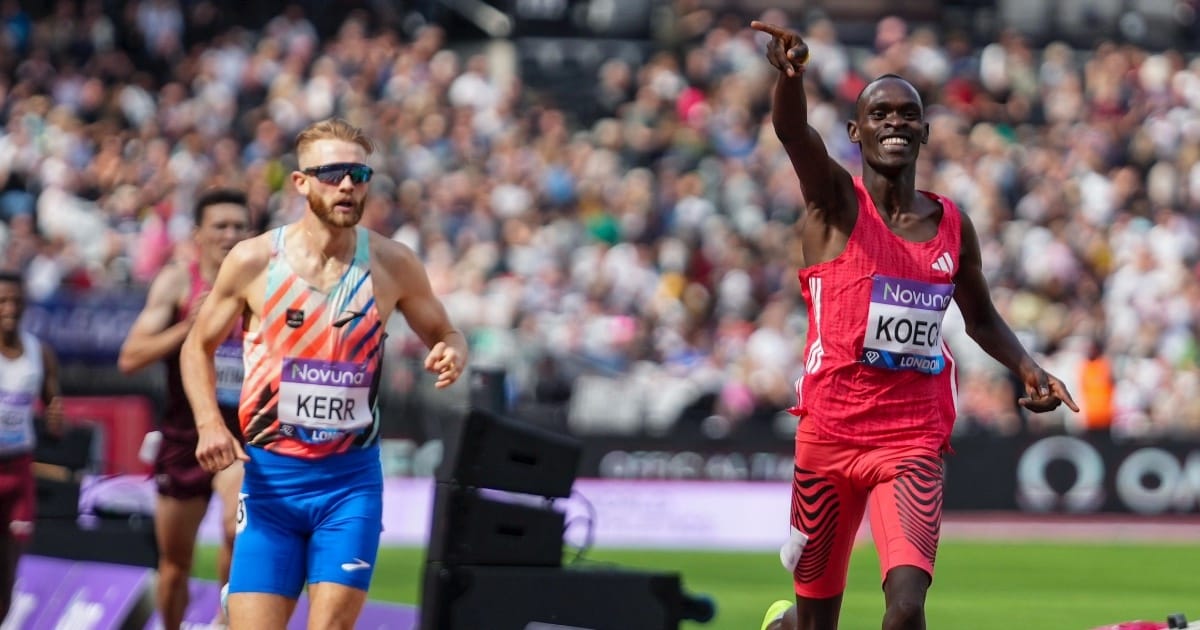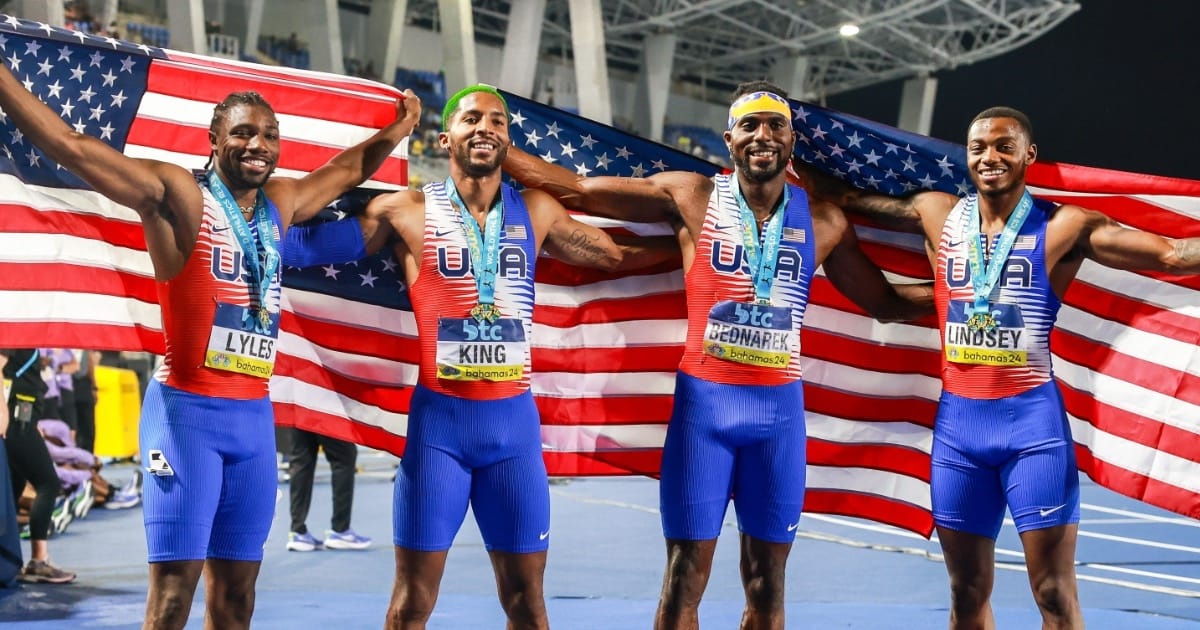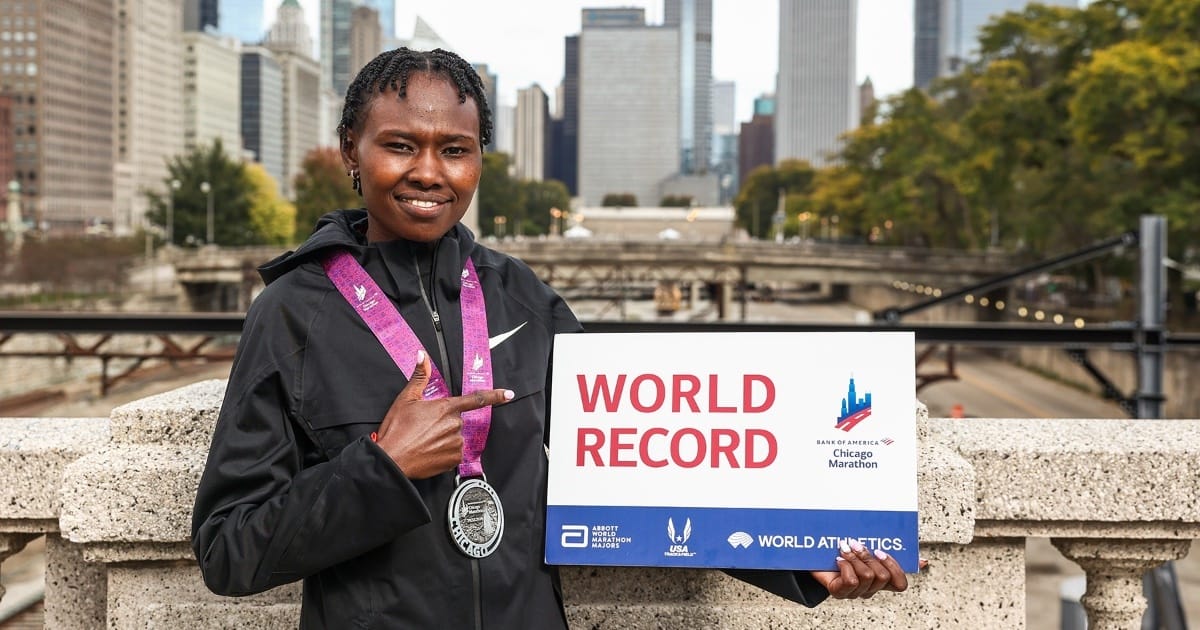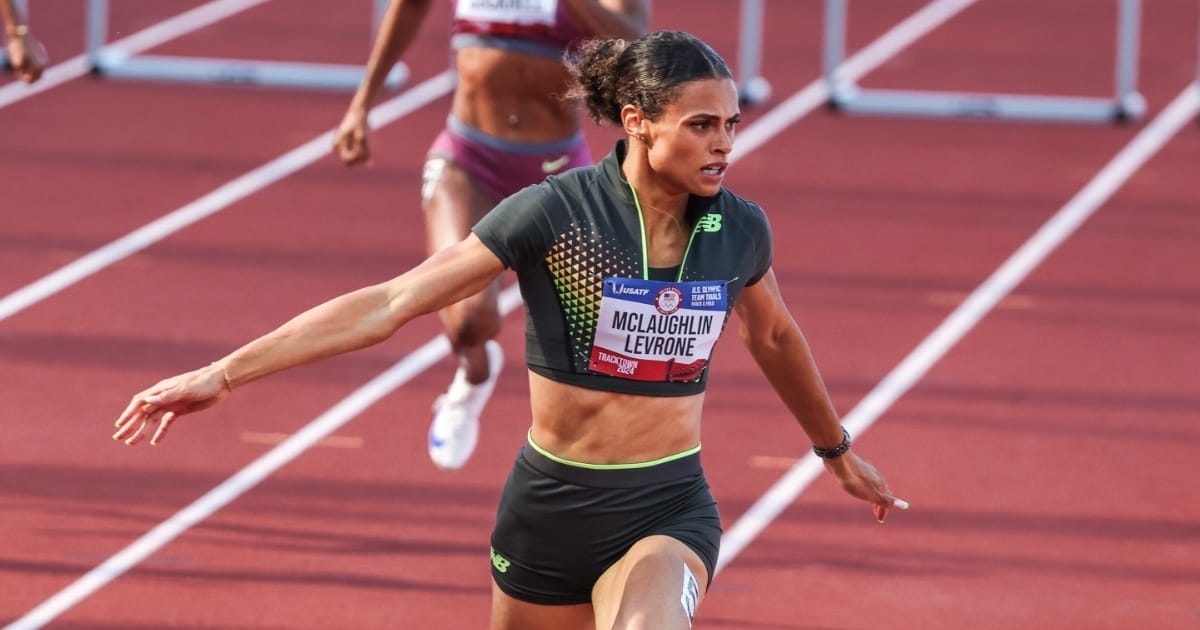- The Lap Count
- Posts
- If You Ain't First... ⏱️
If You Ain't First... ⏱️
Lap 230: Sponsored by New Balance & Olipop
Sponsored by New Balance
The FuelCell Rebel v5 was built to feel fast—and look the part. With a sleek, race-inspired mesh upper and lightweight PEBA/EVA foam blend, it offers a responsive, energetic ride that’s ideal for everything from steady miles to speedwork. A redesigned heel and added forefoot rubber provide comfort and traction, making this your go-to for runs when you want to pick up the pace. Already a favorite among the CITIUS MAG team and worn by New Balance NIL athlete and U.S. HS 400m record holder Quincy Wilson. Find New Balance’s FuelCell Rebel v5 here.
Compiled by David Melly and Paul Snyder
A Tale Of Two Places 🥇🥈

Phanuel Koech & Josh Kerr | Photo courtesy Diamond League AG
It was the best of times; it was the worst of times. It was the age of fast sprints and the era of dramatic kicks. It was the start of the season for some and a midsummer turning point for others.
It was the last Diamond League for nearly a month, before everyone heads back home for their respective national championships. And the 60,000 or so largely local fans who packed London’s Olympic stadium had plenty to cheer for, with Georgia Hunter Bell (800m, 1:56.74), Charlie Dobson (400m, 44.14), and Morgan Lake (HJ, 1.96m) picking up big wins over stacked fields, alongside a world-leading 41.69 4x100m win over Jamaica in the pre-TV program.
At any Diamond League meet, there’s a big difference between finishing first and second—in prestige, in cash (a $4,000 difference, to be precise). But also for season trajectories and the narratives athletes will carry into the latter half of the season.
Women’s 200m: 1. Julien Alfred, 2. Dina Asher-Smith
Even after losing to Melissa Jefferson-Wooden in the 100m at Pre, Olympic champ Julien Alfred still has to be considered the favorite or at least co-favorite in that event in Tokyo. The 2024 World Indoor champ over 60 meters has always been considered better at the shorter sprints, despite her Olympic silver in the 200m in Paris. But Alfred and her coach Edrick Floreal have dedicated significant time to building up her strength and comfort over longer events, opening up the 2025 season with a couple of 300m and 400m races and not running a 100m until her seventh competition of the year.
It’s paying off: In London, Alfred decimated the field, notably opening up her biggest gap over the last 50 meters and crossing the line in a world-leading 21.71. That puts her in a three-way tie for #9 on the all-time list, just 0.11 behind Olympic champ Gabby Thomas’s lifetime best and 0.24 seconds ahead of the reigning Olympic champ’s fastest time this season. Whether or not you think Alfred is now the favorite in the 200m, if anyone is going to pull off the 100m/200m sweep this year, she’s got the best odds.
Alfred’s fellow Coach Flo disciple Dina Asher-Smith took second in 22.25, a season’s best in what’s already been a long haul for the Texas-based Brit. Asher-Smith has struggled in the past to stay healthy, but she’s up to 12 competitions (and 15 total races) already this year, a good sign of consistency even if the PBs haven’t quite come yet. Alfred may be the hot new name on the scene, but Asher-Smith has been around the block a fair few times even though she’s only 30 years old. (She’s been to three Olympics and has nine global medals, including a gold and silver in the 200m and 100m at 2019 Worlds.) If anyone knows how to peak at the right time, it’s her. Whether the 0.54 second gap between the two training partners closes by September will likely depend more on whether Alfred can sustain her blistering momentum—Asher-Smith is largely a known quantity who should continue to improve and sharpen her way into podium contention, but Alfred’s true ceiling is heretofore unknown.
Men’s 100m: 1. Oblique Seville, 2. Noah Lyles
Perhaps the biggest headline coming out of the UK would be the Olympic champion losing his first 100-meter race of the season. But there’s more to the story.
Eight days prior, Noah Lyles made his hotly-anticipated return to the 200m, where he defeated Olympic champ Letsile Tebogo head-to-head in Monaco with a 19.88 victory. Despite his largely quiet spring, Lyles didn’t show any sign of rust. In London, however, he was trounced by Oblique Seville, 9.86 to 10.00. Lyles got beat out of the blocks by at least half the field but was able to claw his way back to a second-place finish, thanks to his unmatchable top speed. Meanwhile Seville, the 24-year-old Jamaican, got away early and was never seriously challenged by the reigning World and Olympic champion.
For Lyles, this result was the definition of a mixed bag. It was actually 0.01 seconds faster than his first 100m of 2024… but that was in April, at a small meet in Florida. Not in July under the bright Diamond League lights. The 100m is a race where practice makes perfect, and given that Lyles is only one rep deep into the season, 10.00 is just the starting point. But 25 men have run faster this year, and Seville himself was handily beaten by Kishane Thompson at their national championships. Track and field’s occasionally dubious transitive property suggests Lyles clearly has some work to do to get ahead of the Paris silver medalist.
For Seville, this is a stellar follow-up to his runner-up finish in Kingston. He’s now got a 2-2 lifetime record against Lyles, and is the only man to defeat him in a 100m final since the end of 2023. But we already know that Seville can deliver in the middle of the season: he ran 9.82, 9.82, and 9.83 in June last year, but a podium finish at a championship has evaded him thus far. He was eighth in last year’s Olympic final and fourth at the last two Worlds, so while a big win here has to be a great confidence booster heading into the meat of the season, he’s ultimately gotta replicate this performance in Tokyo.
Men’s 1500m: 1. Phanuel Koech, 2. Josh Kerr
With Josh Kerr set to race in front of a favorable home crowd, expectations were high—Kerr even spoke pre-race about targeting his own British record of 3:27.79. He made his intentions clear during the race, too, sticking on the prescribed pace just behind fellow Brit George Mills once the rabbits stepped off. In the final lap, Kerr made a strong move around Mills with 250 meters remaining that would have likely been a fatal blow… had Phanuel Koech not made the same move at the same time on the inside, securing pole position.
Kerr was able to put two full seconds on the field (impacted by Mills getting tripped up and breaking his wrist in a fall) in the last 200 meters, but even that wasn’t enough to catch the Kenyan wunderkind, who claimed his first Diamond League victory in 3:28.82 in only the fourth 1500m of his short career. Two months ago, Koech had never raced a 1500m, and now he’s the world junior record holder with 3:27, 3:28, and 3:29 clockings on his card. It’s wildly premature to call the 18-year-old Koech the favorite for Worlds, particularly given that he’s never so much as raced a senior championship, and finished fifth in the 800m at World Juniors last year. But unless he can’t handle racing through the rounds, it’s looking more and more likely that he’ll be in the mix for the medals.
Kerr may have not gotten the victory or the record he wanted, but he still went home with a season’s best 3:29.37. Koech looks like the man of the moment in the 1500m, but Kerr is a paragon of consistency. He’s broken 3:30 in four of the last five seasons now, and he and Jakob Ingebrigtsen are the only two men to make every championship final going back to 2019. Koech is an even bigger wild card than either Alfred or Seville, but it’s clear the talent is there—the question now is whether he’s able to sustain his ascent, or even plateau respectably into September.
Women’s mile: 1. Gudaf Tsegay, 2. Jessica Hull
The women’s mile results presented an interesting contrast as well, but this event didn’t come down to a battle between an experienced veteran and a promising newcomer. Both Gudaf Tsegay and Jessica Hull have been laying high-quality brick after brick on the international circuit for years now, and while both came away with the fastest mile time of their careers, it’s hard to be considered up-and-coming when you’ve already arrived.
Tsegay is maybe the best runner in the world to not be the best runner in any event. She has nine global medals (five outdoor, two indoor), including two World golds—the 5000m in 2022 and the 10,000m in 2023. She’s #3 all-time in the 1500m (3:50.30), #2 all-time in the 5000m (14:00.21), and #3 all-time in the 10,000m (29:05.92). She just happens to have the great misfortune of entering her prime at the same time as Faith Kipyegon, Sifan Hassan, and now Beatrice Chebet.
With her daring run in London, where she passed the pacer in the first lap en route to a 59.9 400m split, Tsegay is now also the second-fastest woman all-time over one mile (4:11.88). Tsegay’s career almost has a tragic nature to it—she’s able to put up extraordinary performances left and right but never quite receives the shine of her rivals.
Hull, on the other hand, is rarely considered a true world-beater, but has made quite the career out of chasing the record-setters. Her run in London was reminiscent of last year’s Diamond League effort in Paris, where Hull clocked her 3:50.83 PB by hanging on as long as she could to Kipyegon’s eventual world record. With that and her 4:13.68 last weekend, Hull now sits at #5 and #6 on the 1500m/mile all time lists. And while her medal shelf isn’t quite as robust as Tsegay’s, the silver she earned last summer felt like a huge breakthrough, as she joined Lisa Martin (silver in the 1988 marathon) and Brenda Jones (silver in the 1960 800m) as the only Australian women’s distance Olympic medalists.
In the titular Dickens novel, the two cities in question are London and Paris. For the purposes of this hamfisted newsletter theme, we’re talking about London and Tokyo. In two months, when we get a replay of these matchups, how will we view the results from last weekend in contrast to the results in Japan? Did we just witness the first cracks of crumbling facades, or rock-solid foundations being laid for a September peak? Will the finishing places stand or flip? Will someone else entirely take first? Only time will tell.
This Week’s Crazy Idea: Run The 4x100m At USAs 🎽

Noah Lyles, Kyree King, Kenny Bednarek, Courtney Lindsey | Photo by Kevin Morris / @kevmofoto
With the 2025 USATF Outdoor Championships coming up next week, there will be plenty of time to speculate, make predictions, and generally get hyped up now that entries are closed and declarations will start to trickle in.
Before we even get there, however, let’s leapfrog this year’s edition into the future. World Athletics is almost too comfortable tinkering with its meet formats, whether it’s the introduction of the mixed-gender relay, the newly-planned “Ultimate Championships” in off-years, or the constant specter of loonier ideas like the long jump takeoff zone. But USATF rarely, if ever, messes with its tried-and-true national trials format, sticking steadfastly to a relatively predictable schedule and top-three-make-the-team selection policy.
Generally speaking, that’s great!
We like USAs; it’s a fun, high-stakes meet that (in non-Olympic years) is packed with action but shorter and easier to digest than a full global championship. But even a great product can be improved. And there’s one thing that both the World and NCAA Championships have that USAs is missing: relays.
Relays at a national championship aren’t new by any means. Countries from Kenya to Spain and everywhere in between feature 4x100s and 4x400s already. But the U.S.—where clubs play an extremely limited role in its professional track and field ecosystem—hasn’t yet seen the appeal of ending a championship with baton-based action, and so we select our relay squads for Worlds using a somewhat murky selection procedure of top finishers in the open events.
So here’s an idea worth at least piloting… instead of selecting the six legs of the 4x100m using the top finishers in the 100m and 200m finals, run one straight-final 4x100m at the end of USAs with a winner-take-all approach: top finishing team gets four of six relay spots. The additional two spots can then be filled by the top two finishers in the men’s and women’s 100m (or the top two to accept them, should someone defer).
Entire training groups could run together (think Dennis Mitchell’s women sprinters) or ad-hoc all-star teams could form in the weeks and days leading up to the race. Either option would presumably lead to better team synergy than our current setup. To create even more intrigue, USATF could leave the declarations open until the final day of competition, allowing athletes to assemble teams or trade spots at the last minute. It would open the door for more non-100-meter specialists to land on the relay (are you reading this, Grant Holloway?) and give athletes only entered in one event, like Aleia Hobbs or Erriyon Knighton, a bit more TV time.
The downside, ultimately, would be less flexibility for Team USA to field the strongest—on paper—possible team at Worlds. But unless something totally crazy happens, any team featuring the 1-2 finishers from USAs plus up to four sprinters capable of getting the stick around quickest in Eugene should be capable of contending with any nation in the world for gold, even Jamaica. And no one previously eligible for the relay pool would be explicitly excluded from a shot at the team—you simply need to find three friends and get the job done on the day. If anything, that’s more in keeping with our current selection process than nebulous, political decision making by a coaching staff behind closed doors. Heck, we might accidentally stumble into better outcomes overall if the 4x1s we choose have more practice and better chemistry…
Ending USAs with a high-stakes 4x100m race would be an entertaining addition to the program without adding much in terms of time or stress. It would create an opportunity for redemption arcs of athletes that miss the final and another chance to give our sport’s most recognizable faces a few more minutes on screen. As Wayne Gretzky probably would’ve said if he was a runner: “you drop 100 percent of the batons you don’t carry.”
Sponsored by Olipop
Olipop transported Nicholas Duvernay back to his childhood for a few hours… 💭
Nicholas Duvernay’s OLIPOP Soda Story takes him back to visits from his grandfather who would treat him to root beer. “Anytime I drink a root beer or crack open a can, I immediately think of him.”
Give that flavor and all the rest a try at DrinkOlipop.com and use code CITIUS25 for 25% off all orders. The best Olipop deal on the internet!
How To Still Have Optimism Post-Ruth Chepngetich Suspension 🙏

Ruth Chepngetich | Photo by Kevin Morris / @kevmofoto
Back in October of 2024, fresh off Ruth Chepngetich running an implausibly fast 2:09:56 Chicago Marathon in which she finished 11th overall, we concluded our thoughts on the performance by saying: “So while 2:09 seems crazy for now, it might end up feeling a lot more normal very soon.”
Nine months later, 2:09 still seems crazy—one might even say unbelievable. Nobody has come close to matching that time. And it was not normal! Mid-last week, news broke that Chepngetich has been provisionally suspended by the Athletics Integrity Unit after a positive test on March 14th for Hydrochlorothiazide, a masking agent, per WADA.
While this bust probably didn’t surprise all that many people, it certainly sent shockwaves of gloom throughout the sport. As a fan (or competitor) how do you absorb this news without spiraling into doomerism?
Chepngetich getting caught with 190x the minimum reporting concentration of a powerful diuretic suggests that she and her team were risking her health to conceal the use of actual performance enhancers. Oh, and about her team… Chepngetich says she is self-coached and, while a Nike athlete, does not represent a particular training group. She’s represented by Federico Rosa, an agent associated with at least six other high-profile athletes who have or are actively serving doping bans.
Surely the buck doesn’t stop with Chepnegetich? It’s not entirely unreasonable to dismiss every pro as filthy, and assume the whole enterprise is rotten, top to bottom—only suckers think anyone could run that fast without a little pharmaceutical assistance.
Sure you could slap on a tinfoil hat and spend your time compiling vibe-based “CLEAN WORLD RECORD LISTS.” But given that you’re here, reading thousands of more laudatory words about track, we’re assuming you’ve got a bit more hope, or at least want to believe that there’s some integrity remaining in the sport. So to you, we want to offer the following spin: the system worked.
An athlete who was (allegedly!) using illegal substances was caught relatively shortly following a hard-to-believe performance and was provisionally suspended within a year of the mark. Ideally, she’d have been caught before crossing the finish line in Chicago and that her positive test would trigger an invalidation of the record (which will likely still stand even if her provisional suspension holds), but here we are.
We’re not encouraging you to bury your head in the sand. As long as there has been sport, there have been people cheating in sport. It’d be naive to assume a high-profile athlete won’t get caught with their hand in the diuretic cookie jar again. But the point remains: they do get caught! Probably not every cheater, certainly not every time. But plenty get nabbed, and you have to assume that when it happens, other nefarious-doers clean up their act, at least for a bit.
The clean athletes who finished behind her are probably looking at their lesser bank accounts and not taking much solace in this outcome, nor should they. It’s not a perfect system, but as of now, it’s the best one we’ve got.
Chepgnetich’s case and the outrage it triggered will hopefully also lead to more substantive conversations about how World Athletics, the World Marathon Majors, sponsors, and other well-heeled stakeholders with power can do better. Simply having the ability to look up Chepngetich’s agent on the WA database and draw our own conclusions is a transparency measure that hasn’t always been available, and there are many additional steps WA can and should consider to protect clean sports.
It’s easy, logical even, to despair. But if you care about track and field, you owe it to yourself and the sport to believe that there’s honor in clean competition. The upside to the demoralizing frequency of AIU press releases is that there are a lot of them—there are more suspensions in track and field now than ever before because there’s a lot of testing going on.
The best case scenario is that gold medals and big checks go to the fastest clean athlete on the first try. The next best is to make sure that the right athletes ultimately get their due—even if it takes years. And to not aim for either of those two goals at all is a white flag of surrender that we’re not willing to wave.
More News From The Track And Field World 📰

Sydney McLaughlin-Levrone | Photo by Kevin Morris / @kevmofoto
– Some major surprises out of the event declarations for USAs: Sydney McLaughlin-Levrone forgoing the hurdles in favor of the flat 400m. McLaughlin-Levrone notably does not have a bye for the 400mH (Femke Bol is the reigning World champ), so she’s all in on the 400m (and presumably the 4x400m) at Worlds, assuming she qualifies. While her initial absence on the entry list stirred up speculation, Athing Mu is now entered to contest the 800m.
– Get your favorite Elmo costume dry-cleaned and start visualizing your purchase at the M&M store—you’ve finally got an excuse to head to Times Square. Athlos has announced it’s hosting a long jump-only competition on October 8th of this year, smack dab in “the Crossroads of the World!” Tara Davis-Woodhall, Jasmine Moore, Monae' Aliya Nichols, and Quanesha Burkes have already been announced as headliners.
– Though some selection events already took place as part of the Pre Classic, Kenya’s World Championship trials were partially ignored in favor of a black box selection process held earlier in the week to help round out the team for Tokyo. The women’s 10,000m squad looks formidable: Beatrice Chebet, Agnes Ngetich, and Janeth Chepngetich; recent NCAA champs Doris Lemngole and Pamela Kosgei made the cut in the steeple; and two Cheruiyots (Ronald and Timothy) join Phanuel Koech in the 1500m.
– At the Night of Athletics in Heusden, Belgium, Winfred Yavi won the steeple in 8:49.59, the third sub-8:50 of her career (she’s the only woman to do it more than once and now has five of the ten fastest times in history). About 30 seconds later, the rest of the field started rolling in, proving it’s possible to make a statement outside of the Diamond League circuit—you just have to win by a humongous amount.
– Speaking of… at the Meeting Madrid, Camryn Rogers tossed the hammer 78.09m—that’s the defending World and Olympic champ’s third competition over 78m this season—to claim the title by nearly 5m.
– Following his Nuguse-slaying victory at the Bowerman Mile, Niels Laros skipped out on the fanfare of the Diamond League and opted to compete in the European U23 Champs. The 20-year-old Dutchman secured wins in the rarely contested 800m-5000m double, going 1:44.36 (and running 1:44.19 in qualification) and 13:44.74.
– Of the four mid-D athletes we dubbed “underdogs to watch” ahead of last month’s NCAA Championship, two didn’t make the final, and the two who did finished last. Well, we’re pleased to announce that the Lap Count curse may have been lifted: BYU’s Riley Chamberlain (1:59.75) and NAU’s Colin Salhman (1:44.89) both ran lifetime 800m bests in winning fashion at the Stumptown Twilight.
– Though no longer the USATF 8k championship, the Crazy 8s 8k in Kingsport, Tennessee, still managed to attract a solid field. Correct us if we’re off base here, but victors Andrew Colley (22:36) and Tristin Colley (26:37) may be the first husband-wife duo we’ve highlighted in this section of the newsletter for winning the same race.
– Rest in peace, Joe Vigil. The visionary coach helped kickstart the Adams State distance dynasty and was instrumental in developing modern training philosophy, and helping share it with countless other coaches and athletes. Runner’s World’s John Kissane wrote more about Vigil’s life and legacy.
Interested in reaching 20,000+ dedicated runners and track and field fans? Advertise with us here.
On a scale of 1-5, how much did you enjoy this week's newsletter? |


Reply